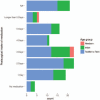Single-center, retrospective study of the outcome of laparoscopic inguinal herniorrhaphy in children
- PMID: 29384943
- PMCID: PMC6393017
- DOI: 10.1097/MD.0000000000009486
Single-center, retrospective study of the outcome of laparoscopic inguinal herniorrhaphy in children
Abstract
Laparoscopic hernia repairs are used increasingly in children.The purpose of this single-center cohort observational research study was to analyze the outcome of children treated surgically for unilateral or bilateral inguinal hernia using laparoscopy.We did a STROBE-compliant retrospective outcome analysis of pediatric, laparoscopic hernia repair. Consecutive laparoscopic herniorrhaphies in 123 children done between March 2, 2010, and March 1, 2014, were included in this analysis. Data analysis was based on reviewing the hospital records and a prospective questionnaire. We evaluated postoperative hernia recurrence rate, occurrence of postoperative complications, duration of postoperative pain medication, and wound cosmesis.We first performed laparoscopic inguinal herniorrhaphy according to the techniques described by Schier et al and Becmeur et al in March 2010. We treated 46 girls and 77 boys with laparoscopically confirmed inguinal hernias, and their ages ranged from 0 to 16 years. Of these, 77 children suffered from unilateral hernias, 30 from unilateral hernias with contralateral patency of the vaginal process, and 16 from indirect bilateral hernias. The median follow-up interval was 38 months (range: 13-58 months). Overall, 8 (6.5%) of these 123 patients experienced a recurrence of the inguinal hernia. Two patients (1.6%) suffered a postoperative infection. Postoperative pain medication was administered by parents for 1 to 3 days in 67 (63.8%) of the 105 families who answered the question, and no pain medication was administered by 5 (4.0%) parents. Wound cosmesis was rated by the parents as invisible or barely visible in 106 (86.2%) of 123 patients and esthetically disturbing in 4 (3.2%) children.Laparoscopic inguinal hernia repair carries a learning curve and is safe and efficient in children thereafter. Further prospective studies are required to evaluate the long-term outcome of laparoscopic inguinal hernia repair in children.
Copyright © 2017 The Authors. Published by Wolters Kluwer Health, Inc. All rights reserved.
Conflict of interest statement
All authors declare that they have no conflict of interest or financial ties to disclose.
Figures



Similar articles
-
Laparoscopic inguinal hernia repair by modified peritoneal leaflet closure: Description and initial results in children.J Pediatr Urol. 2018 Jun;14(3):272.e1-272.e6. doi: 10.1016/j.jpurol.2018.02.015. Epub 2018 Mar 13. J Pediatr Urol. 2018. PMID: 29958645 Free PMC article.
-
The Burnia: Laparoscopic Sutureless Inguinal Hernia Repair in Girls.J Laparoendosc Adv Surg Tech A. 2017 Apr;27(4):430-433. doi: 10.1089/lap.2016.0234. Epub 2017 Mar 30. J Laparoendosc Adv Surg Tech A. 2017. PMID: 28358588
-
Comparison of single-incision laparoscopic percutaneous extraperitoneal closure (SILPEC) and open repair for pediatric inguinal hernia: a single-center retrospective cohort study of 2028 cases.Surg Endosc. 2017 Dec;31(12):4988-4995. doi: 10.1007/s00464-017-5472-6. Epub 2017 Jun 8. Surg Endosc. 2017. PMID: 28597284 Free PMC article.
-
Evidence supporting laparoscopic hernia repair in children.Curr Opin Pediatr. 2018 Jun;30(3):405-410. doi: 10.1097/MOP.0000000000000612. Curr Opin Pediatr. 2018. PMID: 29461296 Review.
-
Contralateral exploration and repair of occult inguinal hernias during laparoscopic inguinal hernia repair: systematic review and Markov decision process.BJS Open. 2021 Mar 5;5(2):zraa020. doi: 10.1093/bjsopen/zraa020. BJS Open. 2021. PMID: 33688950 Free PMC article.
Cited by
-
Single-incision approach for bilateral inguinal hernia repair in children: A retrospective study.Medicine (Baltimore). 2020 Feb;99(9):e19376. doi: 10.1097/MD.0000000000019376. Medicine (Baltimore). 2020. PMID: 32118783 Free PMC article.
-
Dexmededomidine in pediatric unilateral internal inguinal ring ligation.World J Clin Cases. 2022 Jul 26;10(21):7376-7385. doi: 10.12998/wjcc.v10.i21.7376. World J Clin Cases. 2022. PMID: 36157988 Free PMC article. Clinical Trial.
-
Laparoscopic hernia repair in children: does recreating the open operation improve outcomes? A systematic review.Hernia. 2023 Oct;27(5):1037-1046. doi: 10.1007/s10029-023-02772-5. Epub 2023 Mar 23. Hernia. 2023. PMID: 36949270 Free PMC article.
-
Derivation of a complication burden score based on disability-adjusted life years to assess patient burden following surgery: a pilot study.Can J Surg. 2020 Nov-Dec;63(6):E517-E526. doi: 10.1503/cjs.004819. Can J Surg. 2020. PMID: 33155974 Free PMC article. Review.
-
A Modified Approach for Single-Port Laparoscopic Repair of Inguinal Hernias in Children.Adv Biomed Res. 2020 Oct 30;9:63. doi: 10.4103/abr.abr_80_20. eCollection 2020. Adv Biomed Res. 2020. PMID: 33457346 Free PMC article.
References
-
- Schumpelick V, Zimmer M, eds. Atlas of Hernia Surgery. New York: Decker; 1990.
-
- Kiesewetter WB, Oh KS. Unilateral inguinal hernias in children. Arch Surg 1980;115:1443–5. - PubMed
-
- Esposito C, Montinaro L, Alicchio F, et al. Technical standardization of laparoscopic herniorrhaphy in pediatric patients. World J Surg 2009;33:1846–50. - PubMed
-
- Lee Y, Liang J. Experience with 450 cases of micro laparoscopic herniotomy in infants and children. Ped Endosurg Innov Techn 2002;6:25–8.
-
- Schier F, Montupet P, Esposito C. Laparoscopic inguinal herniorrhaphy in children: a three-center experience with 933 repairs. J Pediatr Surg 2002;37:395–7. - PubMed
Publication types
MeSH terms
LinkOut - more resources
Full Text Sources
Other Literature Sources

